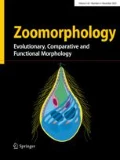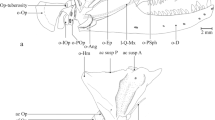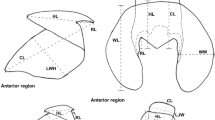Abstract
Some species of Clariidae (air breathing catfishes) have extremely well developed (hypertrophied) jaw closing muscles that increase the maximal biting force of these species. As these enlarged jaw muscles tightly cover the suspensoria, which are firmly connected to the neurocranium, we expect diminished lateral expansions during suction for species with hypertrophied jaw muscles. In turn, this could imply a reduced suction performance for these species. Compared to Clarias gariepinus, which has relatively small jaw closers, Clariallabes longicauda shows a clear hypertrophy of the jaw adductors. A kinematic analysis of prey capture in these two species is presented here. As predicted, Clariallabes longicauda shows less lateral expansion (average abduction of the hyoids of 19.0°) than Clarias gariepinus (abduction of 31.1°). However, our data indicate that the decrease in lateral expansion capacity in the species with excessive adductor development is compensated for by a larger and faster ventral expansion of the buccal cavity by depression of the hyoid.








Similar content being viewed by others
References
Adriaens D, Verraes W (1996) Ontogeny of cranial musculature in Clarias gariepinus (Siluroidei: Clariidae): the adductor mandibulae complex. J Morphol 229:255–269
Adriaens D, Verraes W (1997) Ontogeny of the hyoid musculature in the African catfish, Clarias gariepinus (Burchell, 1822) (Siluroidei: Clariidae). Zool J Linn Soc 121:105–128
Adriaens D, Aerts P, Verraes W (2001) Ontogenetic shift in mouth opening mechanisms in a catfish (Clariidae, Siluriformes): a response to increasing functional demands. J Morphol 247:197–216
Aerts P (1991) Hyoid morphology and movements relative to abducting forces during feeding in Astatotilapia elegans (Teleostei: Cichlidae). J Morphol 208:323–345
Aerts P, Osse JWM, Verraes W (1987) Model of jaw depression during feeding in Astatotilapia elegans (Teleostei: Cichlidae): mechanisms for energy storage and triggering. J Morphol 194:85–109
Alexander RMCN (1965) Structure and function in catfish. J Zool Lond 148:88–152
Alexander RMcN (1970) Mechanics of the feeding action of various teleost fishes. J Zool Lond 162:145–156
Alfaro ME, Janovetz J, Westneat MW (2001) Motor control across trophic strategies: muscle activity of biting and suction feeding fishes. Am Zool 41:1266–1279
Barel CDN (1983) Towards a constructional morphology of cichlid fishes (Teleostei, Perciformes). Neth J Zool 33:357–424
Bouton N, Witte F, Van Alphen JJM, Schenk A, Seehausen O (1999) Local adaptations in populations of rock-dwelling haplochromines (Pisces: Cichlidae) from southern Lake Victoria. Proc R Soc Lond B 266:355–360
Bruton MN (1979) The food and feeding behaviour of Clarias gariepinus (Pisces: Clariidae) in Lake Sibaya, South Africa, with emphasis on its role as a predator of cichlids. Trans Zool Soc Lond 35:47–114
Cabuy E, Adriaens D, Verraes W, Teugels GG (1999) Comparative study on the cranial morphology of Gymnallabes typus (Siluriformes: Clariidae) and their less anguilliform relatives, Clariallabes melas and Clarias gariepinus. J Morphol 240:169–194
Devaere S, Adriaens D, Verraes W, Teugels GG (2001) Cranial morphology of the anguilliform clariid Channallabes apus (Günther, 1873) (Teleostei: Siluriformes): are adaptations related to powerful biting? J Zool Lond 255:235–250
De Visser J, Barel CDN (1996) Architectonic constraints on the hyoid’s optimal starting position for suction feeding of fish. J Morphol 228:1–18
De Visser J, Barel CDN (1998) The expansion apparatus in fish heads, a 3-D kinetic deduction. Neth J Zool 48:361–395
Diogo R, Chardon M (2000) Anatomie et fonction des structures céphaliques associées à la prise de nourriture chez le genre Chrysichthys (Téléostei: Siluriformes). Belg J Zool 130:21–37
Ferry-Graham LA (1998) Effects of prey size and mobility on prey-capture kinematics in Leopard sharks Triakis semifasciata. J Exp Biol 201:2433–2444
Ferry-Graham LA, Wainwright PC, Westneat MW, Bellwood DR (2001) Modulation of prey capture kinematics in the Cheeklined Wrasse Oxycheilinus digrammus (Teleostei: Labridae). J Exp Zool 290:88–100
Herrel A, Adriaens D, Verraes W, Aerts P (2002) Bite performance in clariid fishes with hypertrophied jaw adductors as deduced by bite modelling. J Morphol 253:196–205
Jobson JD (1992) Principal components, factors and correspondence analysis. In: Fienberg S, Olkin I (eds) Applied multivariate data analysis, vol 2. Categorical and multivariate methods. Springer, Berlin Heidelberg New York, pp 345–482
Lauder GV (1981) Intraspecific functional repertoires in the feeding mechanism of the characoid fishes Lebiasina, Hoplias, and Chalceus. Copeia 1981:154–168
Lauder GV (1985) Aquatic feeding in lower vertebrates. In: Hildebrand M, Bramble DM, Liem KF, Wake DB (eds) Functional vertebrate morphology. Belknap (Harvard University Press), Cambridge, MA, pp 210–229
Liem KF (1980) Adaptive significance of intra- and interspecific differences in the feeding repertoires of cichlid fishes. Am Zool 20:295–314
Liem KF (1993) Ecomorphology of the teleostean skull. In: Hanken J, Hall BK (eds) The skull, vol 3. Functional and evolutionary mechanisms. University of Chicago Press, Chicago, pp 422–452
Muller M, Osse JWM (1984) Hydrodynamics of suction feeding in fish. Trans Zool Soc (Lond) 37:51–135
Muller M, Osse JWM, Verhagen JHG (1982) A quantitative hydrodynamical model of suction feeding in fish. J Theor Biol 95:49–79
Nemeth DH (1997) Modulation of buccal pressure during prey capture in Hexogrammos decagrammus (Teleostei: Hexagrammidae). J Exp Biol 200:2145–2154
Ralston KR, Wainwright PC (1997) Functional consequences of trophic specialization in pufferfishes. Funct Ecol 11:43–52
Richard BA, Wainwright PC (1995) Scaling the feeding mechanism of largemouth Bass (Micropterus salmoides): kinematics of prey capture. J Exp Biol 198:419–433
Teugels GG (1996) Taxonomy, phylogeny and biogeography of catfishes (Ostariophysi, Siluroidei): an overview. Aquat Living Resour 9(hors série):9–34
Teugels GG, Adriaens D (2003) Taxonomy and phylogeny of Clariidae. An overview. In: Arratia G, Kapoor AS, Chardon M, Diogo R (eds) Catfishes, vol I. Science Publishers, Enfield, pp 465–487
Turingan RG, Wainwright PC (1993) Morphological and functional bases of durophagy in the queen triggerfish, Ballistes vetula (Pisces, Tetraodontiformes). J Morphol 215:101–118
Van Leeuwen JL, Muller M (1984) Optimum sucking techniques for predatory fish. Trans Zool Soc Lond 37:137–169
Wainwright PC, Lauder GV (1986) Feeding biology of sunfishes: patterns of variation in the feeding mechanism. Zool J Linn Soc 88:217–228
Wainwright PC, Ferry-Graham LA, Waltzek TB, Carroll AM, Hulsey CD, Grubich JR (2001) Evaluating the use of ram and suction during prey capture by cichlid fishes. J Exp Biol 204:3039–3051
Acknowledgements
We thank Jeannine De Vree for assistance during the experiments. Special thanks to L. Van Meir (Vertebrate Morphology, Ghent University) for adopting parts of the morphological analysis of Clariallabes longicauda and F. Huysentruyt (Vertebrate Morphology, Ghent University) for comments on feeding ecology of clariids. This study was supported by the FWO grant 6.0388.00. The authors gratefully acknowledge support of the Special Research Fund of the University of Antwerp. Thanks to F. Ollevier and F. Volckaert for providing us with Clarias gariepinus larvae. Special thanks to M. Stiassny and C. Hopkins for making available the equipment for the sampling in Gabon. A.H. is a postdoctoral fellow of the fund for scientific research—Flanders (FWO-Vl).
Author information
Authors and Affiliations
Corresponding author
Rights and permissions
About this article
Cite this article
Van Wassenbergh, S., Herrel, A., Adriaens, D. et al. Effects of jaw adductor hypertrophy on buccal expansions during feeding of air breathing catfishes (Teleostei, Clariidae). Zoomorphology 123, 81–93 (2004). https://doi.org/10.1007/s00435-003-0090-3
Received:
Accepted:
Published:
Issue Date:
DOI: https://doi.org/10.1007/s00435-003-0090-3




